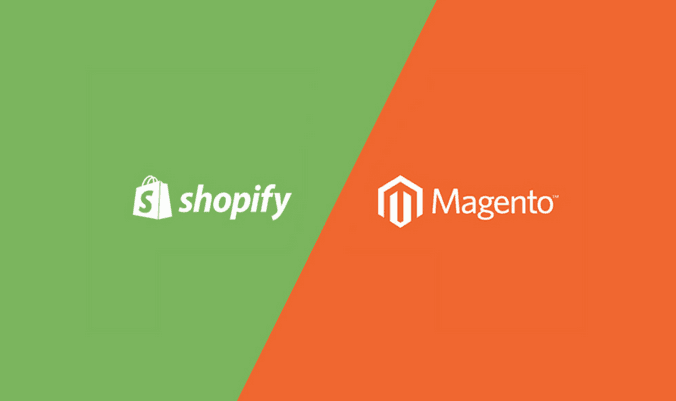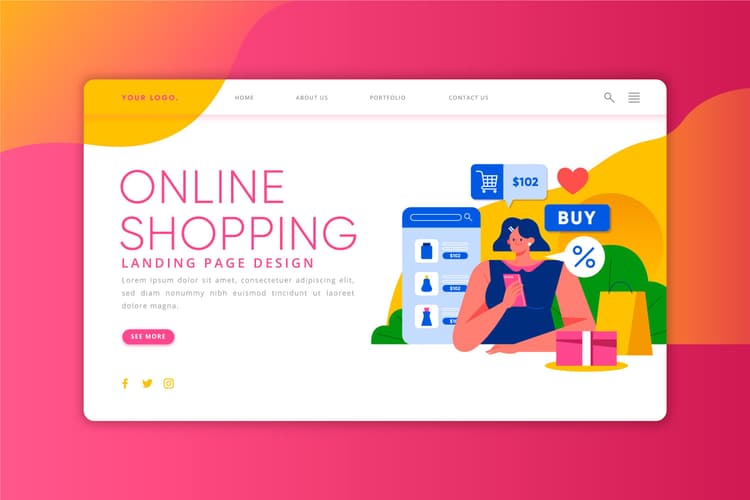Shopify Vs. Magento: 2024 Comparison

E-commerce revenues reached $5 trillion in 2021 and are projected to rise to $7 trillion by 2025. The e-commerce sector presents abundant opportunities, making it enticing for entrepreneurs to join. With a plethora of e-commerce platforms available, such as Magento (Adobe Commerce) and Shopify, setting up an online business, selling products, and managing orders has become accessible. Both Magento and Shopify are widely utilized, supporting numerous merchants worldwide. They empower retailers to tailor their online stores, enhance brand interactions, and streamline business processes. However, the choice between the two depends on individual requirements. To aid in decision-making, explore our comprehensive comparison of Shopify versus Magento (Adobe Commerce) to determine the optimal platform for your online store.
Shopify vs. Magento (Adobe Commerce): In brief
Shopify is an e-commerce platform designed for effortless online business initiation through its user-friendly website builder and intuitive interface. It offers various sales and e-commerce features alongside compatibility with third-party digital tools. On the other hand, Adobe Commerce (formerly Magento) surpasses basic functionalities, providing businesses of all scales with a robust solution. It enables the creation of consistent customer experiences and facilitates multichannel experiences and deployment of multiple multilingual websites. The Adobe Marketplace boasts 3,600 native integrations, covering site optimization, customer support, marketing, shipping, and fulfillment. While Shopify caters well to small and medium-sized businesses (SMBs) due to its simplicity and limited customization options, Adobe Commerce is more suited for firms seeking to craft distinctive branded experiences and incorporate complex functionalities into their websites.
Shopify Plans
All Shopify plan tiers grant users the ability to construct an online store, access reporting functionalities, utilize point-of-sale (POS) systems, list unlimited products, and conduct sales across social media and online marketplaces. Despite Shopify's accommodating pricing plans tailored for businesses of varying sizes, their features cater to distinct company needs. The Basic plan restricts users to two staff accounts, whereas the Advanced plan expands this to 15 staff accounts. Moreover, the online credit card processing fee ranges from 2.9% plus 30 cents per transaction for the Basic plan to 2.4% plus 30 cents per transaction for the Advanced plan. Positioned between these tiers, the Shopify plan offers an intermediate blend of features, enhancing some basic functionalities without providing the comprehensive capabilities of the Advanced plan. While larger enterprises may consider the Plus plan, which commences at $2,000 per month, this might not be a viable option for most small businesses due to its substantial cost.
Magento (Adobe Commerce) Plans
Formerly known as Magento, Adobe Commerce now presents a range of advanced features including a user-friendly drag-and-drop page builder, AI-powered product recommendations, streamlined inventory management, and robust reporting capabilities. While pricing details require direct contact with the company, Adobe Commerce offers two primary plans: Commerce Pro and Managed Services.Commerce Pro serves as a comprehensive solution suitable for businesses of all scales. It allows users to tailor their websites, leverage the Adobe Commerce Application, and benefit from built-in security features and cloud infrastructure.Meanwhile, Managed Services provides a cloud-based technology service equipped with specialized expert resources such as Advanced Support Engineers and Customer Success Engineers. These additional services empower enterprises to address escalated incidents and access premium technical support, thereby enhancing the overall customer experience.
Design, Themes and Templates
Shopify offers a selection of 12 themes, both free and premium, ranging from $180 to $360. Users can filter themes based on industry, catalog size, and desired features to refine their search. Each theme comes with customizable settings, enabling users to personalize their websites by adding banners, altering colors, and making adjustments without needing expertise in HTML or CSS.Once a theme is chosen, customization can be effortlessly carried out through Shopify's website builder or by integrating HTML and CSS code.On the other hand, Magento (Adobe Commerce) prioritizes providing users with unlimited flexibility and customization possibilities through its drag-and-drop builder, nine complimentary design themes, and a seamless personalization editor. With an extensive array of plugins and add-ons, users have control over every aspect of their websites, whether it involves building landing pages, managing inventory, or expanding their online presence.Magento's customer segmentation feature allows for tailored content display based on factors like customer address, shopping cart contents, and order history, enhancing engagement with specific audiences. Additionally, its product recommendation feature suggests relevant products based on shopper behavior and product attributes.In terms of design, the choice between Magento and Shopify depends on individual preferences. Shopify's free website builder facilitates the creation of visually appealing storefronts with ease, whereas Magento may be preferable for those seeking extensive customization options.
Sales Features
Shopify boasts robust point-of-sale (POS) software equipped with inventory tracking, comprehensive analytics, and efficient staff management tools. This enables merchants to establish seamless omnichannel processes and fulfill orders through various methods such as local pickup, local delivery, buy online, pick up in-store (BOPIS), or curbside. Additionally, sellers can acquire a POS kit containing a card reader, receipt printer, and barcode scanner at a discounted rate.For merchants targeting international markets, Shopify facilitates the localization of online stores based on geographical regions. It offers easy translation into multiple languages, automatic conversion of prices to customers' local currency, provision for local payment methods, and collection of import taxes at checkout.In contrast, Magento (Adobe Commerce) provides POS systems through extensions and integrates B2B functionality. Tailored for large companies and enterprises, Magento enables users to manage company accounts, curate catalogs, and facilitate the submission of purchase orders or quotation requests by buyers.Overall, Shopify stands out with its advanced sales features suitable for international sales and POS, making it the preferred choice for most merchants. However, businesses focused on B2B sales and catering to company accounts may find Adobe Commerce more aligned with their
Marketing and SEO
Magento relies heavily on its Extensions for marketing functionalities, boasting over 400 extensions covering areas such as advertising, email marketing, marketing automation, CRM, and SEO/SEM. However, successful integration of these extensions may require technical expertise or assistance from a developer.On the other hand, Shopify offers a built-in marketing dashboard featuring key performance indicators (KPIs), automation tools, and insights into top marketing channels. Additionally, merchants can enhance their SEO by adding keywords, optimizing site structure, and submitting their sitemap.For merchants aiming to expand their reach across various channels, Shopify simplifies the process by allowing synchronization of product catalogs with Facebook and Instagram by Meta for social selling. Similarly, products can be synced with the Google Merchant Center to appear in Google Shopping tab search listings.In conclusion, Shopify emerges as the preferred choice due to its integrated marketing features, providing merchants with intuitive tools for marketing their products without requiring extensive technical knowledge.
Reporting and Analytics
Gaining a comprehensive understanding of your business is essential for achieving success, and fortunately, both Shopify and Adobe Commerce offer reporting and analytics features to facilitate informed decision-making.All Shopify subscription tiers provide an analytics page along with financial and product analytics reports. Premium plans grant additional access to orders, sales, and customer reports. Furthermore, integration with Google Analytics 4 is available for more detailed data analysis, enabling monitoring of visitor activity, customer behavior, and sessions.For maximizing the value of data, Magento (Adobe Commerce) offers robust insights. Its Reports Menu offers various reports covering sales, products, customers, and promotions. By activating a Business Intelligence account, users gain access to a personalized dashboard featuring approximately 70 reports tailored to their specific business requirements. The Advanced Reporting dashboard showcases dynamic reports, user-friendly data visualizations, and data-rich dashboards.In summary, Magento excels in providing personalized and dynamic reporting capabilities, making it particularly suitable for large businesses. However, for small businesses, Shopify's reporting features may suffice for their current needs.
Payment Processing
Shopify Payments enables merchants to accept online payments directly without relying on a third-party payment provider. However, transaction fees apply if a third-party payment provider is used. The rates vary based on the Shopify plan:
Basic: 2.9% + 30 cents per transaction (online); 2.7% (in person)
Shopify: 2.6% + 30 cents per transaction (online); 2.5% (in person)
Advanced: 2.4% + 30 cents per transaction (online); 2.4% (in person)
In contrast, Magento lacks a native payment gateway but offers over 300 payment extensions. Popular options include PayPal, Stripe, and Amazon Payments, with fees contingent upon the transaction fee structure of the chosen payment processor. For instance, PayPal imposes a 3.49% plus 49 cents fee for domestic transactions in the U.S. and a 5% fee for international transactions, whereas Stripe charges a 2.9% plus 30 cents fee per transaction.Both Magento and Shopify support payment gateways such as Amazon Pay, Stripe, and PayPal, albeit with transaction fees.In conclusion, Magento emerges as the winner in the payment gateway category due to its broader array of options compared to Shopify. While Shopify Payments simplifies transaction management, the integration of third-party payment options incurs transaction fees.
Apps and Extensions
What sets Magento apart from Shopify? Both platforms boast extensive libraries of apps and extensions. However, Shopify leads in the number of integrations, offering over 8,000 apps compared to Magento's approximately 3,800 extension options.Shopify's App Store encompasses a wide array of applications spanning inventory management, marketing, order processing, store design, and customer support. It seamlessly integrates with popular third-party platforms across various domains, including social media (e.g., Pinterest, TikTok), email marketing tools (e.g., Mailchimp, Klaviyo), shipping carriers (e.g., UPS), and accounting software (e.g., QuickBooks, Xero).On the other hand, the Magento marketplace hosts both free and paid extensions catering to accounting, customer support, marketing, and sales. Moreover, being an open-source platform, Magento allows for extensive customization and the development of custom integrations. This flexibility empowers developers to craft unique integrations tailored to the specific requirements of businesses.In summary, while Shopify excels in the sheer number of integrations available, Magento stands out for its capacity for custom integrations, making it an ideal choice for businesses seeking to connect with specific tools within their workflow.
Ease of Use and Support
Shopify boasts a sleek, contemporary, and user-friendly interface. Its navigation is intuitive, facilitating easy access to features related to products, content, finances, and marketing. New users benefit from a personalized setup guide, guiding them through tasks to launch their store efficiently.With Shopify's customer support available round-the-clock via email and chat, users can seek assistance anytime. The Shopify Help Center offers extensive documentation, video tutorials, and guides for additional support. Furthermore, merchants can engage with fellow members and discuss issues within the Shopify Community.Similarly, Magento (Adobe Commerce) provides an Admin dashboard for product setup, administrative tasks, and sales management. While its dashboard mirrors Shopify's cleanliness and organization, the platform's enterprise-level features may necessitate a learning curve regarding workflows and configuration settings.For technical support, users can initiate support tickets and monitor their status while contacting the support team as needed. The Adobe Commerce Help Center offers a plethora of resources including user guides, support tools, forums, and developer documentation.In summary, Shopify emerges as the more user-friendly option compared to Magento (Adobe Commerce). Regardless of one's technical proficiency, setting up an online store and managing products is straightforward with Shopify.
Summary
Both platforms offer entrepreneurs the opportunity to establish and sell products online. For first-time entrepreneurs working within a limited budget, Shopify is the preferred choice due to its user-friendly interface and simplicity. On the other hand, Magento (Adobe Commerce) is tailored for businesses of all sizes seeking extensive customization and personalization options. However, it comes at a higher cost, making it more suitable for medium to large enterprises with substantial budgets. For a comprehensive comparison of e-commerce platforms, you can refer to our article on the best options available.Who Benefits Most from Shopify?
Small businesses: Shopify's built-in features, including inventory management and secure payment gateways, enable companies to concentrate on core operations.
Dropshippers and print-on-demand businesses: Shopify seamlessly integrates with dropshipping platforms and print-on-demand services, simplifying inventory management, order fulfillment, and shipping.
Retailers with physical stores: Shopify's point-of-sale (POS) system facilitates the integration of online and offline sales channels, providing a unified shopping experience for retailers with brick-and-mortar stores.
Who Benefits Most from Magento (Adobe Commerce)?
Large and enterprise-level businesses: Magento is equipped to handle complex and high-volume e-commerce operations, managing large product catalogs, multiple stores, and international markets.
B2B e-commerce: Magento supports intricate pricing structures, negotiated quotes, curated catalogs, multiple buyer accounts, and integration with enterprise resource planning (ERP) systems, catering to the unique needs of B2B businesses like wholesalers and manufacturers.
International companies: With Magento's capability to support extensive product catalogs and manage operations in global regions, it is well-suited for businesses targeting multilingual audiences, offering localization options for product descriptions, metadata, and names.
www.e9.digital - [email protected]
Shopify Development Service, E-commerce Solutions, Online Store Optimization | E9 Digital Agency
192 Tran Quang Khai, District 1
Ho Chi Minh city, Vietnam
More Topics

Small Business SEO: Boost Your Online Presence Traffic
In today’s digital landscape, small businesses face fierce competition. Building a strong online presence is crucial for success, and SEO is a key part of that. SEO helps improve your website's visibility on search engines like Google, making it easier for customers to find you.

How To Run a SEO Audit for Your Ecommerce Store
Boost Your Ecommerce Success: Mastering SEO Audits for Increased Visibility & Sales

Top Shopify Themes 2024
Explore the five best Shopify themes, including the versatile Dawn, to enhance your online store's appearance and functionality for an optimal shopping experience.
Let start your
project together
Tell us your idea and we will make it happen together.
